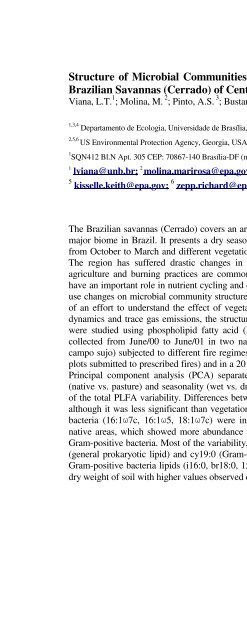A Look at Amazon Basin Seasonal Dynamics with the Biophysical ...
A Look at Amazon Basin Seasonal Dynamics with the Biophysical ... A Look at Amazon Basin Seasonal Dynamics with the Biophysical ...
Structure of Microbial Communities in Native Areas and in a Pasture inBrazilian Savannas (Cerrado) of Central BrazilViana, L.T. 1 ; Molina, M. 2 ; Pinto, A.S. 3 ; Bustamante, M.C. 4 ; Kisselle, W.K. 5 ; Zepp, R.G. 61,3,4 Departamento de Ecologia, Universidade de Brasília, Brasília, DF2,5,6US Environmental Protection Agency, Georgia, USA1 SQN412 Bl.N Apt. 305 CEP: 70867-140 Brasília-DF (mailing adress)1lviana@unb.br; 2 molina.marirosa@epa.gov; 3 aspinto@unb.br; 4 mercedes@unb.br;5 kisselle.keith@epa.gov; 6 zepp.richard@epa.govThe Brazilian savannas (Cerrado) covers an area of 2 million Km 2 and represents the secondmajor biome in Brazil. It presents a dry season from April to September and a rainy seasonfrom October to March and different vegetation covers that varies in woody species density.The region has suffered drastic changes in land use with conversion of native areas toagriculture and burning practices are common during the dry season. The microorganismshave an important role in nutrient cycling and ecosystem functioning and the effects of landusechanges on microbial community structure and function are not well understood. As partof an effort to understand the effect of vegetation changes and fire regimes on the nutrientdynamics and trace gas emissions, the structure and dynamic of soil microbial communitieswere studied using phospholipid fatty acid (PLFA) analysis. Soil samples (0-5 cm) werecollected from June/00 to June/01 in two native vegetation types (cerrado sensu stricto ecampo sujo) subjected to different fire regimes (2 plots protected from fire since 1992 and 2plots submitted to prescribed fires) and in a 20 year-old active pasture (Brachiaria brizantha).Principal component analysis (PCA) separated microbial communities by vegetation type(native vs. pasture) and seasonality (wet vs. dry), explaining 45,8% and 25,6%, respectively,of the total PLFA variability. Differences between burned and unburned sites were observedalthough it was less significant than vegetation cover and seasonality effects. Gram-negativebacteria (16:1ω7c, 16:1ω5, 18:1ω7c) were in higher concentrations in the pasture than innative areas, which showed more abundance of lipids from eukaryotic microorganisms andGram-positive bacteria. Most of the variability, during the dry season, were explained by 16:0(general prokaryotic lipid) and cy19:0 (Gram-negative lipid) and, during the wet season, byGram-positive bacteria lipids (i16:0, br18:0, 15:0). Total PLFA varied from 7,1 to 41,0 µg/gdry weight of soil with higher values observed during the wet season.
- Page 726: Organic matter composition of river
- Page 730: Natural and athropogenic influences
- Page 734: Carbon Accumulation in Amazon Várz
- Page 738: Relation between photosintesys and
- Page 742: Laura Tillmann Viana University of
- Page 746: HUMAN DIMENSIONS AND METRICS OF LAN
- Page 750: ABSTRACTDEFORESTATION CONTROL IN MA
- Page 754: 1PREDICTORS OF DEFORESTATION IN THE
- Page 758: Simulating land cover change along
- Page 762: ASSESSING THE EVOLUTION OF LAND USE
- Page 766: Introducing New Agricultural Techno
- Page 770: Forest susceptibility to fire durin
- Page 774: Committed carbon emissions from def
- Page 780: Priority Areas for Establishing Nat
- Page 784: Trace gas evolution with landuse gr
- Page 788: Impact of land cover and land use c
- Page 792: Soil trace gas emissions influenced
- Page 796: Emissions of CO 2 , CH 4 , N 2 O, a
- Page 800: NO x and CO emissions from soil and
- Page 804: Methane dynamics in undisturbed for
- Page 808: ut soil temperature was not. Absenc
- Page 812: Influence of Amazônia Land-use Cha
- Page 816: ISOPRENOID FLUXES AND PHOTOSYNTHETI
- Page 820: Concentration profiles of volatile
- Page 824: Abstract submitted for presentation
Structure of Microbial Communities in N<strong>at</strong>ive Areas and in a Pasture inBrazilian Savannas (Cerrado) of Central BrazilViana, L.T. 1 ; Molina, M. 2 ; Pinto, A.S. 3 ; Bustamante, M.C. 4 ; Kisselle, W.K. 5 ; Zepp, R.G. 61,3,4 Departamento de Ecologia, Universidade de Brasília, Brasília, DF2,5,6US Environmental Protection Agency, Georgia, USA1 SQN412 Bl.N Apt. 305 CEP: 70867-140 Brasília-DF (mailing adress)1lviana@unb.br; 2 molina.marirosa@epa.gov; 3 aspinto@unb.br; 4 mercedes@unb.br;5 kisselle.keith@epa.gov; 6 zepp.richard@epa.govThe Brazilian savannas (Cerrado) covers an area of 2 million Km 2 and represents <strong>the</strong> secondmajor biome in Brazil. It presents a dry season from April to September and a rainy seasonfrom October to March and different veget<strong>at</strong>ion covers th<strong>at</strong> varies in woody species density.The region has suffered drastic changes in land use <strong>with</strong> conversion of n<strong>at</strong>ive areas toagriculture and burning practices are common during <strong>the</strong> dry season. The microorganismshave an important role in nutrient cycling and ecosystem functioning and <strong>the</strong> effects of landusechanges on microbial community structure and function are not well understood. As partof an effort to understand <strong>the</strong> effect of veget<strong>at</strong>ion changes and fire regimes on <strong>the</strong> nutrientdynamics and trace gas emissions, <strong>the</strong> structure and dynamic of soil microbial communitieswere studied using phospholipid f<strong>at</strong>ty acid (PLFA) analysis. Soil samples (0-5 cm) werecollected from June/00 to June/01 in two n<strong>at</strong>ive veget<strong>at</strong>ion types (cerrado sensu stricto ecampo sujo) subjected to different fire regimes (2 plots protected from fire since 1992 and 2plots submitted to prescribed fires) and in a 20 year-old active pasture (Brachiaria brizantha).Principal component analysis (PCA) separ<strong>at</strong>ed microbial communities by veget<strong>at</strong>ion type(n<strong>at</strong>ive vs. pasture) and seasonality (wet vs. dry), explaining 45,8% and 25,6%, respectively,of <strong>the</strong> total PLFA variability. Differences between burned and unburned sites were observedalthough it was less significant than veget<strong>at</strong>ion cover and seasonality effects. Gram-neg<strong>at</strong>ivebacteria (16:1ω7c, 16:1ω5, 18:1ω7c) were in higher concentr<strong>at</strong>ions in <strong>the</strong> pasture than inn<strong>at</strong>ive areas, which showed more abundance of lipids from eukaryotic microorganisms andGram-positive bacteria. Most of <strong>the</strong> variability, during <strong>the</strong> dry season, were explained by 16:0(general prokaryotic lipid) and cy19:0 (Gram-neg<strong>at</strong>ive lipid) and, during <strong>the</strong> wet season, byGram-positive bacteria lipids (i16:0, br18:0, 15:0). Total PLFA varied from 7,1 to 41,0 µg/gdry weight of soil <strong>with</strong> higher values observed during <strong>the</strong> wet season.



